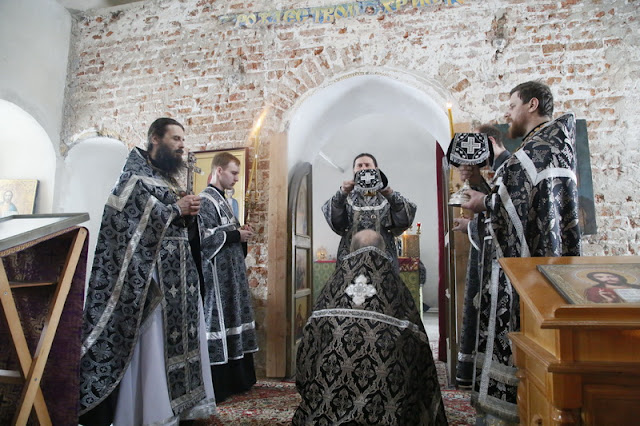As this Divine Liturgy (really Vespers with the
communing of the faithful) is served only on weekdays during Great Lent,
prostrations are done by the faithful at various parts of the service. This
little pamphlet is designed to help you understand when prostrations are done,
as well as explain a few of the interesting anomalies of this Divine Service.
- Prostrations are done when you enter the Church.
Rather than just crossing yourself three times when entering you in fact cross
yourself and prostrate yourself to the ground three times upon entering.
- When lighting candles and kissing the icons
prostrations are done as well. Two prostrations following by the kissing of the
icon, the placing of your candle, and finally a third prostration before the
icon.
- When the curtain is closed (following the third
Small Ektenia), all the faithful (except for the one person reading the psalms)
prostrate themselves to the ground. They do not arise until the curtain has
again been opened.
- After the first reading from the Old Testament the
priest opens the Royal Doors and says “The Light of Christ Enlightens All!” As
he blesses the faithful with the candle the faithful (including the Reader)
make a prostration to the ground.
- During the singing of “Let my prayer arise…” the
faithful and the singers prostrate themselves. The faithful prostrate
themselves while the TRIO is singing (in some parishes the trio actually sings
in the middle of the church on its knees). The trio prostrates itself while the
CLERGY are singing. The people stand while the clergy are singing.
- During the two readings of the Prayer of St. Ephraim
the Syrian (after “Let my prayer arise…” and after the Great Entrance) the
faithful prostrate themselves as does the priest.
- During the Great Entrance the faithful prostrate
themselves as the Holy Gifts are brought out of the altar. They remain
prostrate until the priest says quietly “With faith and love let us draw near…”
- When the Holy Gifts are brought out of the altar for
the Communion of the faithful and the priest says “With the fear of God and
faith draw near!” the faithful prostrate themselves.
- After the Communion of the faithful, when the priest
again brings out the Holy Gifts and says “Always, now and ever, and unto the
ages of ages!” the faithful prostrate themselves.
- If the Presanctified Liturgy is served on any day
but Friday the faithful do three prostrations as they exit the church (except
for those who have communed). If it is Friday we cross ourselves three times as
usual, without prostrations.
The question, of course, arises as to why we are doing
so many prostrations at the Divine Liturgy of the Presanctified Gifts. As we
usually attend church services on Saturday nights and Sunday mornings when
prostrations are forbidden, we feel a bit odd prostrating ourselves on the
floor in the Church. However, we do prostrations on almost all days throughout
the year except on Sundays. When we prostrate ourselves before the Holy Gifts
we express our belief that the Holy Bread and the Holy Wine are truly the Body
and Blood of our Lord Jesus Christ. That is, we bow down before God Himself.
A few other practical tips regarding the Presanctified
Liturgy:
-There is no prosphora offered at the Presanctified
Liturgy. As there is no consecration of the Body and Blood of Christ at this
service (the Gifts were PRESANCTIFIED at the Liturgy on Sunday), there is no
prosphora offered.
- Infants who do not eat solid foods do no commune at
this service according to the ancient tradition of the Church. There is a long
explanation to this practice. Please see Fr. Gregory if you would like to learn
more.
- The cross is not held by the priest following the
service. Again, this is an ancient practice of the Church and reminds us of the
penitential character of Great Lent.
- The priest commemorates the saints from both the day
of the Presanctified Liturgy and the day following, since the Liturgy is
actually a Vespers service and it encompasses aspects of both days.
How to
make a Prostration
Frederica
Mathewes-Green
To make a prostration we make the sign of the cross on
ourselves, kneel, place our hands on the floor and touch our foreheads down
between our hands.
One former Episcopal priest said that seeing people
prostrate themselves was one of the things that made him most eager to become
Orthodox. He thought, "That's how we should be before God."
How to
make a Prostration
“Orthodox
America”
Prostrations are less awkward and less physically
taxing if made in the following manner. Keeping the feet together, bend
slightly and fall "lightly" to the floor, onto the hands, positioning
them at a comfortable distance in front of the knees (which touch the ground
only after the hands) to allow one to spring back up to a standing position,
after lightly touching the head to the floor. It takes very little practice to
master this technique, which requires surprisingly little physical stamina.
Source: http://www.stvladimiraami.org/pamphlets/presanctifiedliturgytips.pdf



















CONVERSATION